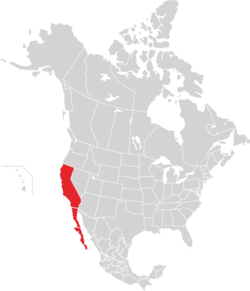
Back الكاليفورنيس Arabic Las Californias Catalan Las Californias CEB Kalifornien (historische Landschaft) German Las Californias Spanish Kaliforniak Basque Kaliforniat Finnish Les Californies French As Californias Galician ラス・カリフォルニアス Japanese
The Californias
Las Californias | |
|---|---|
 | |
| Country |
|
| U.S. state | California |
| Mexican states | Baja California Baja California Sur |
| Principal cities | |
| Area | |
| • Total | 569,329 km2 (219,819 sq mi) |
| Population | |
| • Total | 43,636,740 |
| • Density | 77/km2 (200/sq mi) |
| Time zones | UTC-8 (Pacific Standard Time) |
| • Summer (DST) | UTC-7 (Pacific Daylight Time) |
| UTC-7 (Mountain Standard Time) | |
| • Summer (DST) | UTC-6 (Mountain Daylight Time) |
The Californias (Spanish: Las Californias), occasionally known as The Three Californias[1][2][3][4] or Two Californias,[5][6][7] are a region of North America spanning the United States and Mexico, consisting of the U.S. state of California and the Mexican states of Baja California and Baja California Sur.[8][9][10][11] Historically, the term Californias was used to define the vast northwestern region of Spanish America, as the Province of the Californias (Spanish: Provincia de las Californias), and later as a collective term for Alta California and the Baja California Peninsula.[12][13]
Originally a single, vast entity within the Spanish Empire, administration was split into Baja California (Lower California) and Alta California (Upper California) following the Mexican War of Independence. As a part of the Mexican–American War (1846–48), the American Conquest of Alta California saw the vast Alta California territory ceded from Mexico to the United States. The populated coastal region of the territory was admitted into the Union in 1850 as the State of California, while the vast, sparsely populated interior region would only later gain statehood as Nevada, Utah, and parts of Arizona, Wyoming, and Colorado.
Today, Californias is a collective term to refer to the American and Mexican states bearing the name California, which share geography, history, cultures, and strong economic ties.[14][15]
- ^ "Wilson Center – Institute of the Three Californias" (PDF). Archived from the original (PDF) on 2019-04-12. Retrieved 2018-03-18.
- ^ "Freemasons of California: Conference of the Three Californias". Archived from the original on 2018-07-12. Retrieved 2018-03-18.
- ^ Torrans, Thomas (2002). The Magic Curtain: the Mexican-American Border in Fiction, Film, and Song. TCU Press. ISBN 978-0-87565-257-3.
- ^ Assembly, California Legislature (1942). Journal of the Assembly, Legislature of the State of California.
- ^ Mathes, Michael (1965). "The Two Californias during World War II". California Historical Society Quarterly. 44 (4): 323–331. doi:10.2307/25155757. ISSN 0008-1175. JSTOR 25155757.
- ^ Two California, Three Religious Orders, and Fifty Missions
- ^ Staff, Liberation. "Two Californias meet at the border to demand justice for farm workers – Liberation News". Retrieved 2023-03-18.
- ^ "Missions of the Californias". CA State Parks. Retrieved 2023-03-18.
- ^ "Lieutenant-Governor of California: Commission of the Californias". Archived from the original on 2019-01-02. Retrieved 2018-03-18.
- ^ Geiger, Maynard (April 1952). "The Arrival of the Franciscans in the Californias-1768–1769". The Americas. 8 (2): 209–218. doi:10.2307/978302. ISSN 0003-1615. JSTOR 978302. S2CID 146950170.
- ^ "Video: Is this the first or last beach in the Californias?". Los Angeles Times. 2015-03-06. Retrieved 2023-03-18.
- ^ Farnham, Thomas Jefferson (1844). Travels in the Californias, and scenes in the Pacific Ocean. University of California Libraries. New York : Saxton & Miles.
- ^ School, Stanford Law. "The Case of the Pious Fund of the Californias. United States of America Vs. Republic of Mexico. Replication of the United States of America to the Answer of the Republic of Mexico". Stanford Law School. Retrieved 2023-03-18.
- ^ MexicoMatters – Economy of the Three Californias
- ^ LA Times – What the Baja Boom Means for Our State
© MMXXIII Rich X Search. We shall prevail. All rights reserved. Rich X Search